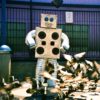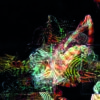Documentation

“A beautifully Uncanny & Fruitful Interaction with a Dinosaur” – Elisavet Kardami
Roos van Berkel and Emilia Barakova’s lecture offered a very fresh perspective on the diverse ways that human and robots can interact, but also the affective potential movement regardless of who or what is generating it. What I found particularly fascinating was how the dinosaur robot (PLEO) that the researchers offered to the audience to…
Read more
“Robots, animals and health care. No humans?” – Gido Broers
This morning I heard on the news that a hospital in a city in the Netherlands started an experiment with healthcare-robots that asks the patient questions to get an indication of the illness of the patient. It wasn’t clear how the robot exactly functions, but it seemed as if the robot only interacts with the…
Read more
“What can movement tell us?” – Irene Alcubilla Troughton
In the lecture given by Emilia Barakova and Roos van Berkel about the importance of expressive movement in social robotics and, consequently, in human-robot interactions, two notions caught my attention from the beginning: anthropomorphic and humane robots. In an extremely interesting distinction between them, the two scholars tried to understand how a robot can or…
Read more
“The fear of the unknown or of the painfully familiar?” – Alexandra Kinevskaya
There is a lot of argument these days when it comes to robots. This topic has become especially actively discussed in recent years, as AI and robotics are no longer in distant future. FESTO with a myriad of insect and animal robots that move just like their prototypes, Boston Dynamics’ with their series of robots…
Read more
“With a little help from animated friends” – Max Peters
One of the main challenges in coordinating robot behavior, as shown by Roos van Berkel and Emilia Barakova in their lecture, centers around the ability to let robots respond to movement and emotion; essential to human behavior. They demonstrated a variety of approaches, ranging from gaze matching to Laban Movement Analysis, and it quickly became…
Read more
“Robotics, Reenactment and Collective Memory” – Nadine Westveer De Mul
I had a very rewarding, enjoyable and inspiring time interning for TiM’s Performing Robots project managed by Professor Maaike Bleeker. As a Research Assistant, I was assigned the primary task of organizing and collecting additional research for the project’s ongoing research archive. Where I divided research and included my own findings into sub-themes and topics,…
Read more
“I am not a robot…or am I?” – Elissavet Kardami
Melvin Waver’s talk, Using Neural Networks to Study Conceptual Shifts in Text and Image, provided some critical insight on the potential of neural networks in conducting academic research in the field of Humanities. The proliferation of available data and the rapid developments in the processing possibilities, in conjunction with the increasing digitization of archives, has…
Read more
“Digital Humanities: the necessity of collaboration” – Gido Broers
In Melvin Wevers’ lecture Using Neural Networks to Study Conceptual Shifts in Text and Image, he explained why humanities researchers should collaborate with computer scientists. He did this by showing a neural network that can analyze and categorize images in advertisements. This network could then recognize certain patterns, which eventually could lead to new insights…
Read more
“Essentialism and free labour – the other side of neural networks” – Irene Alcubilla Troughton
In his talk Using Neural Networks to Study Conceptual Shifts in Text and Image, Melvin Wevers exposed a type of research that, relying on large corpora of data for advertisements, employed computational devices in order to be able to proceed with his analysis. The amount and accessibility of data nowadays, as it has been addressed…
Read more
“On the pedagogy of algorithms” – Tamalone van den Eijnden
The underlying idea of pedagogy is that parents, teachers and other adults bear responsibility for the upbringing, education and conduct of children. These responsibilities range from the mental life of the child to behavioural manners to legal liability. Ideas of the responsibility in education are not only limited to human-human relations but are equally applicable…
Read more
